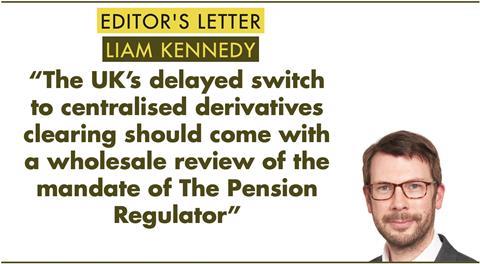After the global financial crisis of 2008-09, world leaders meeting at the Pittsburgh G20 summit mandated central clearing for derivatives. This was to allow for greater supervisory oversight and to mitigate against the unintended build-up of risks of the kind that almost toppled the financial system in the guise of over-the-counter credit default swaps.

From the outset in 2012, EU pension scheme arrangements – large users of interest rate derivatives to hedge liability risks and to match assets with liabilities – were granted a temporary exemption from the central clearing requirement. Central clearing requires the posting of cash as variation margin, which is expensive in a zero or negative interest rate environment. That exemption comes to an end in June.
Brexit has complicated the situation, given that the world’s largest derivatives clearer, the UK’s LCH, is located in an offshore jusrisdiction in relation to the EU. From an operational perspective, LCH is currently the preferable venue for derivatives clearing. Politically, the EU is unwilling to allow such a large volume of activity to take place in a non-EU member state. Therefore, it has decided to phase out LCH’s equivalence status.
The UK, meanwhile, has opted to postpone the central clearing obligation until 2025, which is perhaps understandable in light of the liability-driven investment (LDI) debacle of last autumn, which my colleague Carlo Svaluto Moreolo discusses in this issue.
One observation regarding the UK LDI crisis is that central clearing of trades would not have avoided the liquidity crunch last autumn. Nor will central clearing by itself solve risks stemming from the hedging of interest rates and other practices.
Regulation itself can lead to a build-up of unintended risks. In the Netherlands, the introduction of the FTK financial assessment framework, and mark-to-market liabilities, led to a self-fulfilling feedback loop whereby extensive use of swaps by pension funds led to a reduction in the discount rate and a hike in liabilities.
For some in the UK, pension funds should not have had to hedge liabilities in the first place. For this group, the introduction of mark-to-market accounting forced the market into an unnecessary direction. As many now observe, the trend towards risk mitigation has structurally undermined the UK defined benefit (DB) pension sector’s ability to take long-term risk.
But mark-to-market accounting is a reality with which pension funds everywhere have got to grips. The operational implications have been largely absorbed as the market has sought to manage liability risk with the tools available.
DB pensions account for a large proportion of household wealth in the UK and it is no new observation that the atomisation of risk among thousands of quite small pension schemes is a systemic problem. Decades of regulation have not really kept up with this reality.
The second observation is that pension regulation needs to change. The UK’s now delayed switch to centralised derivatives clearing should be come with a wholesale review of the mandate of The Pension Regulator, potentially accompanied by a merger with the Prudential Regulatory Authority under the auspices of the Bank of England. That would send a much-needed signal that the extent of DB assets and liabilities requires a different level of regulatory oversight.
A beefed-up regulatory regime should impose higher standards of supervision, including incentives to consolidate. These could include a much higher level of trustee knowledge and understanding, enforced by regular one-on-one testing. Pooling of risk through consolidation vehicles could be incentivised by tweaking the level of Pension Protection Fund (PPF) premiums.
A coordination of pensions regulation between the PRA and TPR, or even a merger, makes even more sense, given the increasing role of the insurance market in DB pensions. Capacity is a major constraint in the world of DB buyouts and buy-ins, but it makes little sense for DB pensions to be overseen by TPR when a growing proportion of the assets is managed by insurers through bulk annuities or is in the pipeline for a buyout, and will be under the supervision of the PRA.
The UK’s LDI crisis took place well over six months ago and lessons have been learned. But it would be wrong to be complacent about liability and risk mismatches in the future, particularly in a financial system that seems extraordinarily sensitive to sudden outbreaks of market volatility and liquidity squeezes – and still highly dependent on the capacity of central banks to open the liquidity taps.
There may be no panacea to these ills but among the best preventative measures is for institutions to become as resilient as possible, preferably through scale, with the best standards of internal governance.
Liam Kennedy, Editor
liam.kennedy@ipe.com












































No comments yet